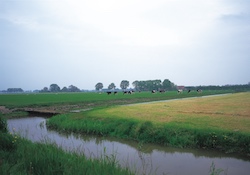SEJournal Online is the digital news magazine of the Society of Environmental Journalists. Learn more about SEJournal Online, including submission, subscription and advertising information.
Backgrounder: Get Wise on Water Rule
By Joseph A. Davis
The U.S. Environmental Protection Agency’s Clean Water Rule defines “waters of the United States,” or WOTUS, in order to clarify when a permit is needed to discharge dredged or fill material under the Clean Water Act’s Section 404, which in turn is meant to prevent the destruction of wetlands.
The Clean Water Rule, which went into effect in 2015, is now the subject of a rollback attempt by the Trump administration (read our accompanying “TipSheet” on story ideas that may emerge as a result).
 |
|
West Texas wetlands. Image: © Clipart.com |
The agriculture, real estate and construction industries (among others) complain that the requirement that they get a permit before firing up their backhoes is burdensome and unnecessary. And the Clean Water Rule has traditionally drawn the deep dislike of the GOP and the American Farm Bureau Federation, which believe it expands waters under the jurisdiction of Section 404.
On the other hand, environmentalists like the requirement or want it even stronger, saying that it helps preserve vanishing wetlands that are a foundation of whole ecosystems — as well as reducing water pollution.
Long history of hostilities
Wrangling over Section 404 goes back decades, and is not something that started under the Clean Water Rule.
How far back? Try the 1820s and 1830s, when the fledgling Corps of Engineers was (with Congress’ backing) trying to develop the nation’s water transportation system. That meant keeping navigable waters free of snags, sediment, sunken steamboats and … well, trash.
By the end of the century, the Corps’ role had been codified under the Rivers and Harbors Act of 1899, which made it illegal to dredge or fill navigable waters without a permit.
So when the first big modern water pollution control law came along in 1972 (the Clean Water Act), it leaned on this pre-existing federal authority (founded on the Interstate Commerce Clause of the Constitution) for the Section 404 program.
It set up a program run jointly by EPA and the Corps. EPA would determine the environmental standards and the Corps would issue the permits. The Clean Water Act’s Section 502 defined “navigable waters” as “waters of the United States.” That was expansive enough to include wetlands, which Section 404 was supposed to be about protecting.
Court cases overturn WOTUS definitions
It worked fairly well, for a while. As implemented by EPA and the Corps, Section 404 has big exemptions for normal farming, irrigation, logging, etc. For certain widespread and low-impact activities, the Corps set up programs of general, or nationwide, permits — meaning you didn’t have to apply for a specific permit.
But it didn’t work well enough, and groups like the Farm Bureau, the National Association of Realtors, National Cattlemen’s Beef Association and the U.S. Chamber of Commerce have chafed.
Then a pair of Supreme Court cases in 2001 and 2006 threw out previous understandings of what “waters of the United States” meant jurisdictionally — without actually settling what it did mean.
That left EPA and the Corps without a clear and workable definition. Congress did not offer one. So EPA finally issued the WOTUS rule in June 2015.
Opponents called the new EPA rule a “power grab” and sued. Those suing included most of the usual opponents, plus some 31 states, led partly by then-Oklahoma Attorney General Scott Pruitt, now the Trump administration’s EPA administrator.
The cases have since reached the federal appeals court level — the Cincinnati-based Sixth Circuit Court of Appeals consolidated some 100 cases and claimed jurisdiction in 2016.
Now, the U.S. Supreme Court has decided to take up the case on narrow jurisdictional grounds. But don’t expect the Supreme Court — or Trump’s executive order — to clear up the mess any time soon.
Joseph A. Davis is editor of WatchDog Tipsheet, and writes the weekly TipSheet and monthly Issue Backgrounders.
* From the weekly news magazine SEJournal Online, Vol. 2, No. 10. Content from each new issue of SEJournal Online is available to the public via the SEJournal Online main page. Subscribe to the e-newsletter here. And see past issues of the SEJournal archived here.













 Advertisement
Advertisement 



